August 30, 2004
Dresden
After leaving Karlovy Vary, we drove though the industrial north of the Czech Republic and stopped in the city of Teplice. We walked through the town, and it was nice, but not as old as many that we have visited. We had dinner and walked back to our pension and retired for the evening.
Press HERE to see a slideshow from the East Germany.
$5000- Coffee Service for Four
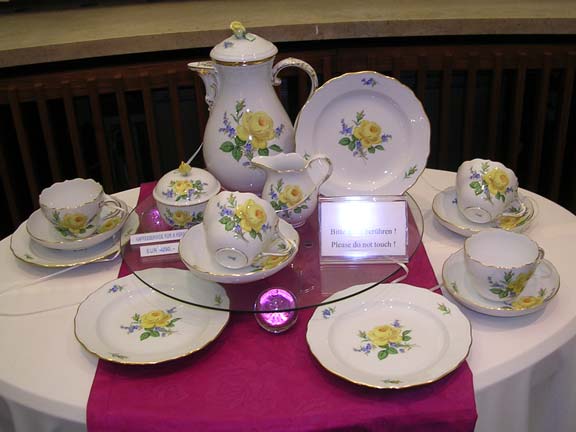
Thursday we stopped a Dubí, just north of Teplice. Betty was still on the hunt for some glassware. She got a nice vase. Then we headed ten miles north to the German border. From here we drove through Dresden and to Meissen. This very small and beautiful town is the home of Meissen porcelain. We stopped by the factory. We decided to skip the tour and just look around in their store. With cup and saucer costing more than $500 and a coffee service for four costing more than $5000, of course, we did not purchase anything. After visiting the store, we visited this beautiful and old little town. We found a room through the local information office. It was a very reasonable private room for $30 per night. Unfortunately we got into a bit of a tiff about the breakfast, when he charged us $11 more after the person at the information office had told us that breakfast was included. The room was on the east side of Meissen. We were less than 300 meters from the Elbe. There is a bike path on this side of the river. The path runs 800 kilometers from the North Sea to the Czech Republic. We saw many bikers and skaters on the path. We only walked for a couple of hundred meters along it, but the beauty of the valley was awesome. By this time it was about 8:00 in the evening. We stopped to eat a wonderful gourmet dinner at the Bauren Hause'l. I had the pork tenderloin and mushrooms and Betty had a chicken breast with a sauce of raspberries, peaches and cheese. Wow, was it great.
Friday we drove to Liepzig. We wandered the city. It is a very nice city. We saw Bach's burial place in St. Thomas church, where we also got a short organ concert. We also visited the church of St. Nicolas - another haut of Bach's. We saw most of the worthwhile sites and we enjoyed watching the people go about the city. About six we drove to Radebeul, a town near Dresden and not far from Meissen. It was late and we could not find a cheap private house, so we stayed at a regular pension that was expensive for us at $55 for a small place in the country.
First thing Saturday morning we got a cheaper place without breakfast but with a kitchen for $40 per night. We drove into Dresden and happened upon a free parking space; paid parking in the center is $7.20 a day. We got a map with a proposed walking route through the city. We tried to find a guided walking tour, but they were all done with sending them out for the day. We did get the route and some info on a bus tour where you can get on and off the bus as often as you like with buses running every half-hour. We declined this tour. It was chess day in Germany. I saw some people from a chess club setting up problems. I asked what was going on and they explained. I did a couple of the problem and nailed them. She asked me to play a game and I accepted. I only play once every year or so, and enjoy a good game. I held my own, but alas I had to surrender. We walked by the main sites in the city. The Frauen Kirche, the Church of Our Lady, was destroyed in WWII, but after the war all the pieces were gathered and numbered. The plan had been to rebuild the church, but little was done until after the reunification of Germany. Now it was rebuilt and being used. It probably will be a few years before it is fully restored, but given the speed of reconstruction in the past ten years - it shouldn't take long to finish. We saw the march of the dukes in Meissen tiles that adorns a block-long castle wall. One of the dukes, Konrad the Great, is in my family tree. By mid afternoon we decided to pick up some groceries and go for a drive. Dresden is a beautiful city that looks like a great place to live. We had a bit to eat and then went to a concert at the Zwinger. It was a nice wind ensemble that performed with ballet dancers telling the story behind the music in dance. We returned to our rooms about nine in the evening.
Frauen Kirche 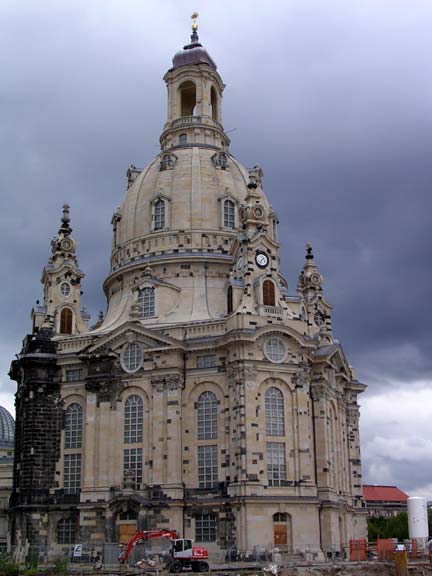 |
Konrad The Great 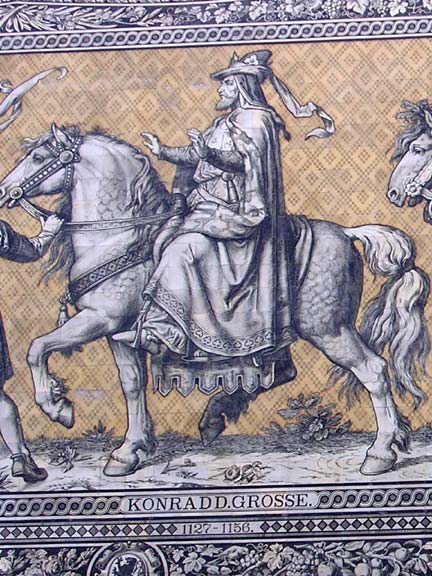 |
Oper House Hallway 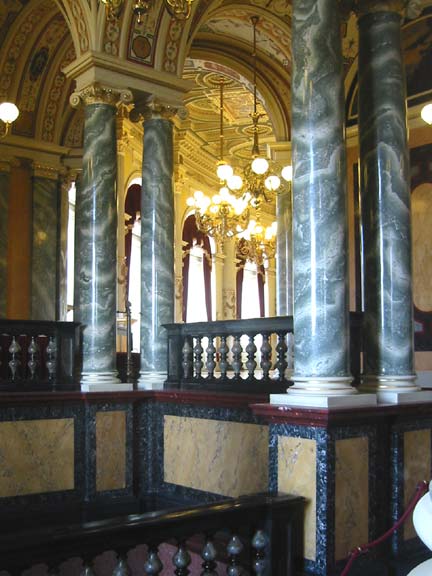 |
Oper House Auditorium 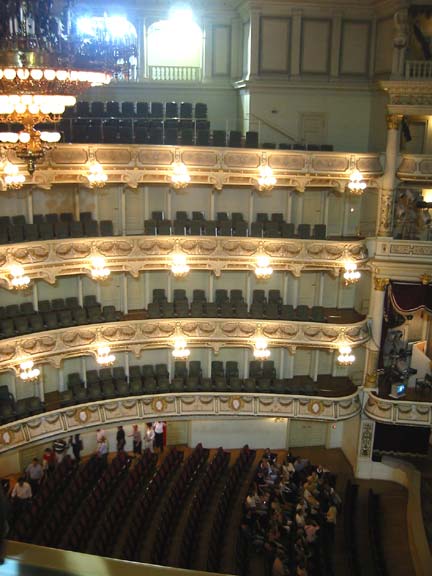 |
We got an extremely late start on Sunday. We were watching the Danes play the Korean women for the gold in the funny handball game that looks a bit like soccer. It was a great game that went into two overtimes. So, we got a late start. First we visited to Frauen Kirche, where we thought we would get a tour. Not so, but we did go down into its basement to hear an explanation of the restoration in German and see a good film on the restoration. Then we wandered about a bit and stopped for beers before visiting the opera house. It is truly a beautiful opera house, one of the finest in Europe. We could not get tickets for the evening performance. By now it was six, so we returned rather early to our rooms. We started to get ready to fly to Germany and then back home by going through all the stuff that we had collected along the way. This was no easy task, but no way could we haul it all back. Then we watched the end of the Olympics, what a show!
A Zwinger Concert with Dance 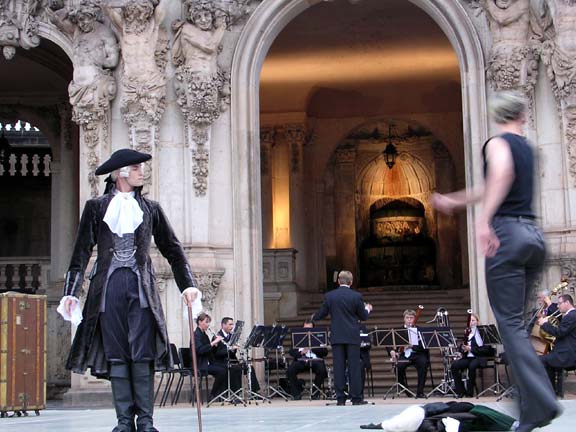 |
The Catedral From the Opera 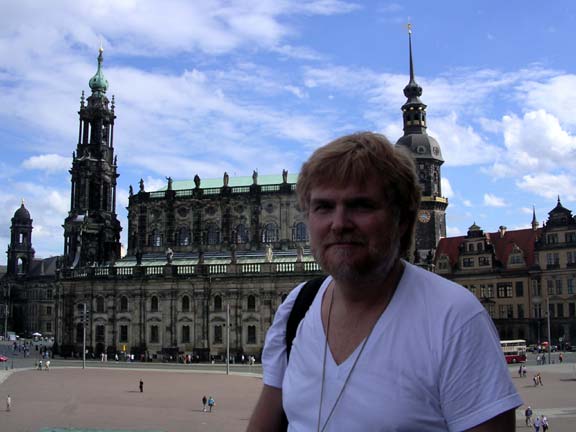 |
Today we returned to Prague. By chance we came upon a hostel just where we wanted to stay on the bus route to the airport. It was the least expensive accommodations on our trip at just $20 per night. Of course at that price there is no breakfast. By the time we got to Prague and checked in it was after four in the afternoon. Before unloading all our gear from the car, we grabbed a beer at a nearby pub. Then we unloaded and decided to head into the center. We walked around for a long time, stopping for the occasional beer and checking out the sights once again. Finally we stopped for dinner. Betty was not too happy with her order, but mine was fine. We got back to the hostel about 10:00 PM.
August 25, 2004
Karlovy Vary
We drove to Plzeň on Sunday the 22nd. Plzeň's German name is Pilsen. This is the town where the first Pilsner or Pils beer was brewed in the mid 1800's. It is the home of the Pilsner Urquell brewery. We stopped in Plzeň to see its main square and to visit the brewery. It is a large brewery that produces about 150 million liters or more than a million barrels of beer each year. The tour was OK. There were several short films to be seen as we trod through mostly the old maturation tunnels running ten kilometers under the brewery and city. Thing is that they really don't use them any more, except for the few dozen vats of beer that they still brew in wooden vats for comparison to the modern day stainless steel vats that were just installed twelve years ago. It was a small glass of this that they provided a taste of during the tour. After the tour there was no tasting room. So, despite the $5 tour fee, there was no beer drinking. They have a restaurant where the beer cost the same as anywhere else in the Czech Republic, about $1 for a pint. The Czechs often seem to lack the ability to understand how one creates good-will about a product or a service experience. In this case it was the beer, in others it has been the wine, and almost daily we have to face this problem in the restaurants. And be aware that I am not talking about prices, because most of these things are inexpensive, it is really about the presentation or the package.
Press HERE to see a slideshow from the Czech Republic.
PilsnerUrquell Brewery 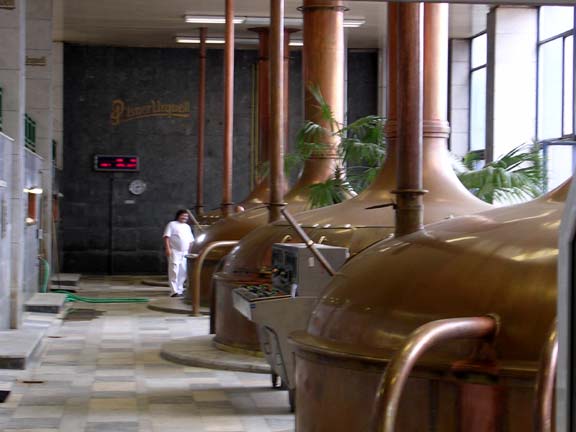 |
Wooden Beer Vat  |
We were also in Plzeň to view the main square. It did not disappoint with its beauty. This one of the outstanding things about the Czech Republic: everywhere - beautiful old cities. Not that the rest of Europe does not have its share of beautiful old cities, because it does. But here in the Czech Republic it seems to be ubiquitous.
From Plzeň we drove north to Karlovy Vary. This turns out to be a huge spa town with thousands of tourists from all over the world, but especially from Russia and the Middle East. It may be the most beautiful of all the Czech cities. Its center lay in a narrow river valley with buildings rising along the adjacent slopes. The city is primarily made up of 19th century buildings. The public spaces along the river are fabulous. People have been coming here for more than 300 years to take the waters. The tourists walk around with odd-looking porcelain cups taking the hot water that spews from one of the dozens of wells found on the streets. The mineral laden water is said to bring good health. You can find all the typical spa services in the town: health clinics, massages parlors, hair salons, etc. The health angle is so prevalent that I saw a hotel called the Sanatorium. The information office was closed. So, we started to look for a pension to stay in. They cost twice what they do most places in the Czech Republic, in other words, they start at $60 a night this time of the year. We drove out of the center and up one of the hills and found a place to stay, A.Dalia privat, in a private home for $44 a night. We may have done better, but we did not have the time to look under every rock to save a few dollars. The family is very nice and the breakfast was included. Their son, Thomas, is eight years old, plays golf, and speaks English fluently - as does his father.
Karlovy Vary River 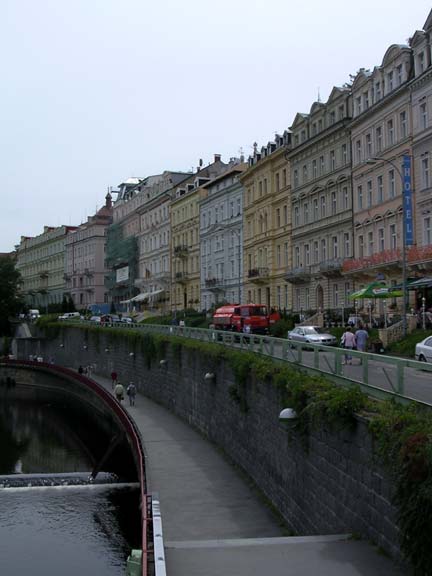 |
Geyser in Karlovy Vary 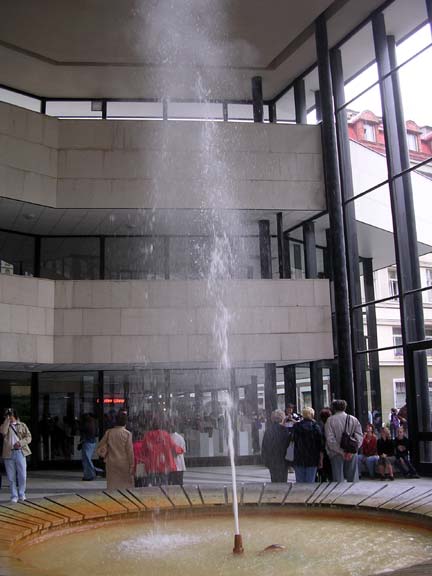 |
River in Center 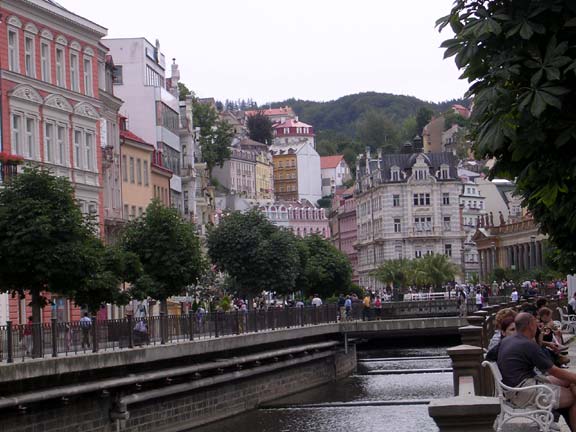 |
Theater 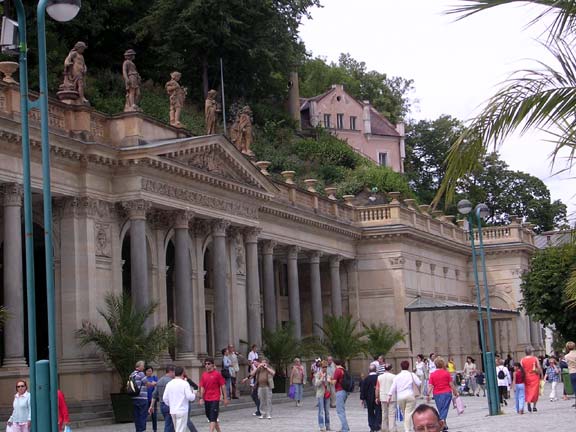 |
Typical Buildings 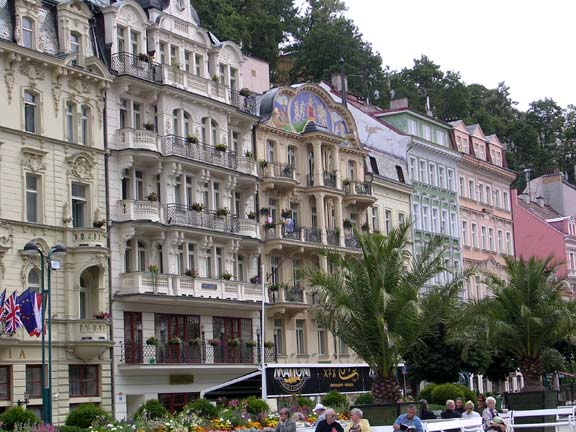 |
Pillar 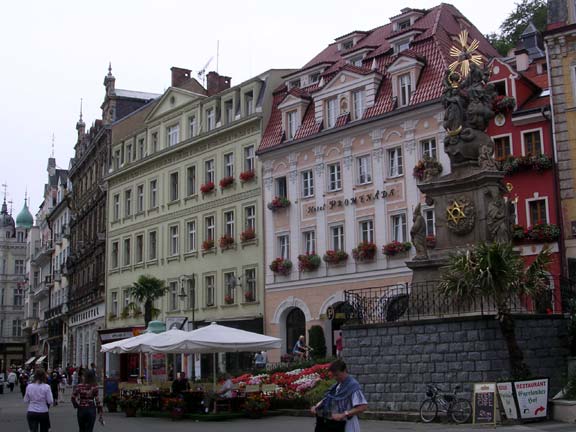 |
Old Buildings in Cheb
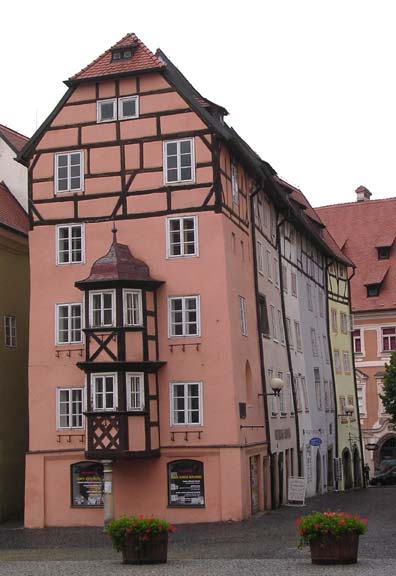
Monday was not the best of days. It seemed like we were going and going but we did not get anywhere. Betty probably enjoyed it more than me. We spent a lot of time in stores that sell crystal and porcelain. Betty got her hair done. While she did that I checked on trains to Germany and the cost. We will visit my friends in Wuppertal. I vaguely recall that the fare last year was high, but now it seems insanely high at $150 each. It is cheaper to fly - which we may well do. When I returned to the salon, she still had another 40 minutes to go. I decided to get a beard trim; I really needed it. We stopped by a internet shop to check on airfares to Germany. We spent way to long there. We also tried to research the possibility of a one-way car rental to Wuppertal, but were unsuccessful in getting a quote. I hope the $110 airline ticket that I found does not disappear. By the time we got out of there it was too late to do much more. We tried the waters and did some more window shopping. We had pizza before returning to our rooms for the night.
It rained a lot on Tuesday. We have seen very little rain on our travels, so I guess we are due. We started trying to figure out how to get to Wuppertal without spending an arm and a leg. EasyJet will start service between Prague and Dortmund next Wednesday, so I booked on them for $47 each; quite the bargain considering what is available. We went to the Moser glass factory. This factory produces some of the most expensive glass pieces in the world with some stems costing more than $400. Only the richest people in the world buy this glass, from the richest capitalists to royalty to movie stars and more. We saw their museum and found out that tours were done for the day and then we drove through some area of the town we had not seen. We decided to visit some small towns nearby. The castle at Loket was from the 13th century. Then we went to Cheb, whose German name is Eger. The city was so beautiful. Some of the buildings seemed to be from the 14th century. We stopped for dinner in a pub housed in a building from 1460's.
Loket's Castle 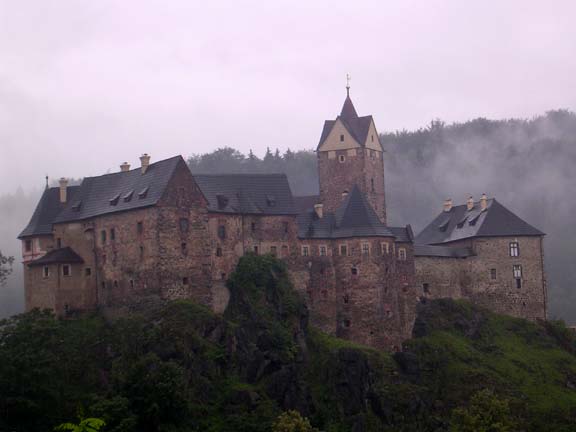 |
Cheb 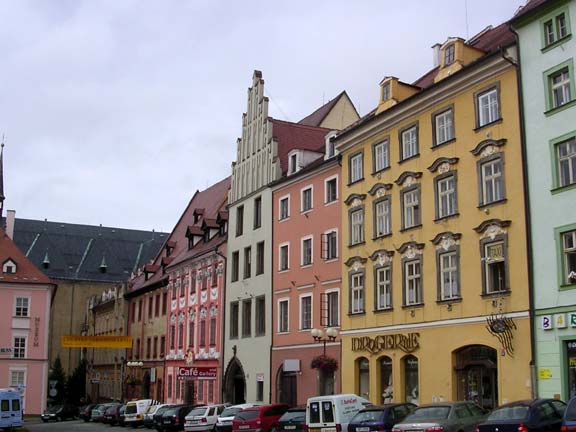 |
There was a Canadian couple in for a wedding at the table this morning (Wednesday). We suggested they join us as we planned to return to the Moser factory for a tour later in the morning. Jim and Lise Nicholson were lovely people from Edmonton. They enjoyed the tour as much as we did. I noted that the reject rate from the blowing room was much less than the 90% rate that we had heard. Less than a fifth of the pieces were sent to the scrap heap. Then Betty and Lise went to a crystal store in the city to get some less expensive glass pieces. We seemed to really click with this couple. They love traveling as much as we do.
By the early afternoon we were headed to the northwest in search of another castle.
The Moser Glass Factory Blowing Room
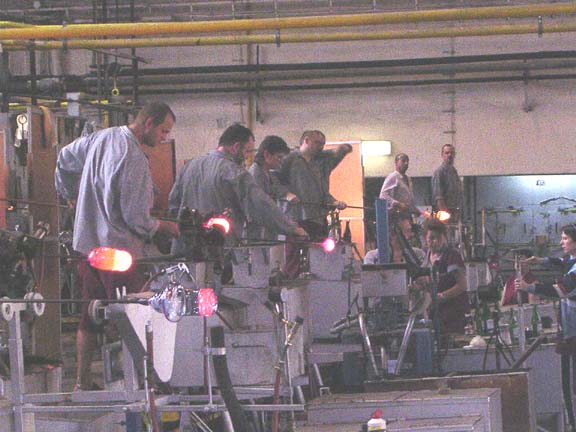 |
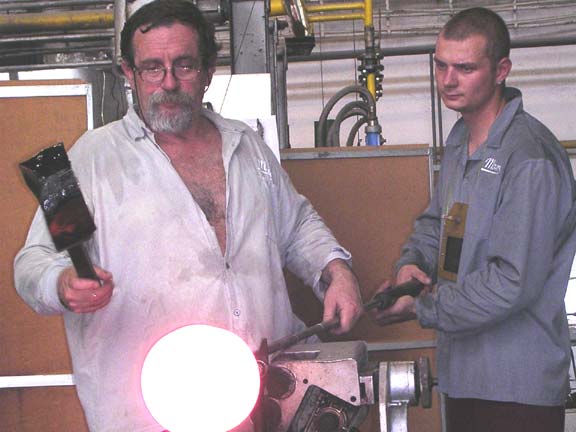 |
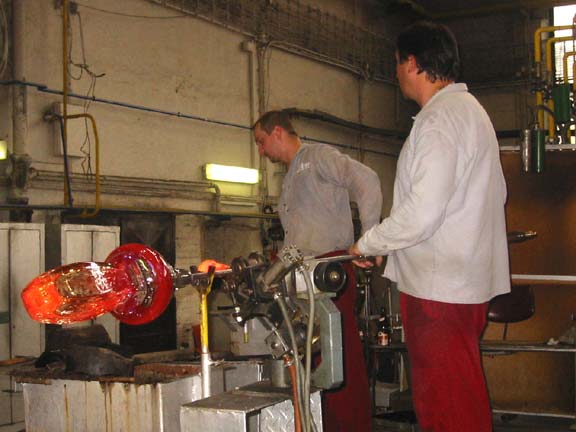 |
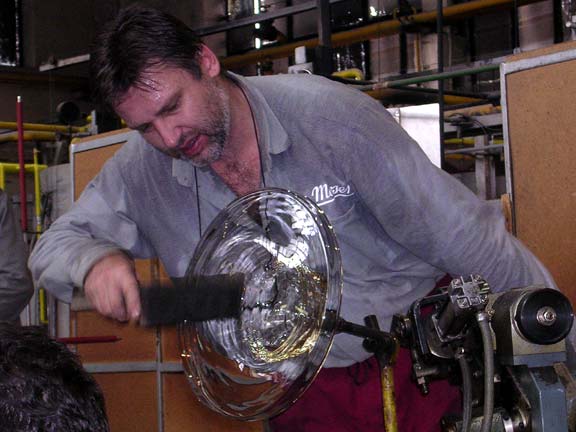 |
Quality Control
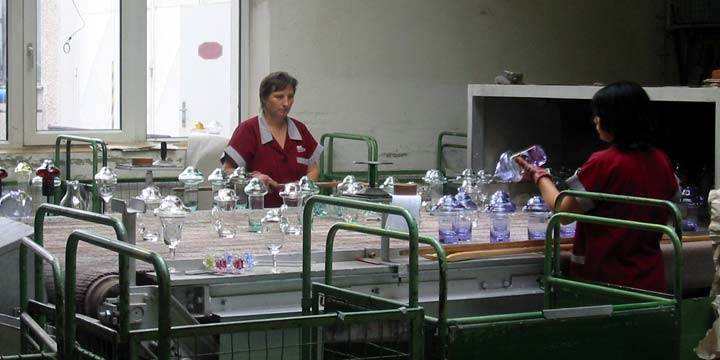
August 21, 2004
From Southern Moravia to Bohemia
We spent two days in Mikulov. We found a nice pension in a small town that had a couple of dozen pensions. Most of them cost about $28 a night for double room. Ours cost $32 and it included breakfast. The Venuše Pension has an interesting cast of characters working at it, but none are more interesting than the owner, Josef Toneček. Close seconds are his daughters Barbara and Tayna. The food in their little restaurant was good too.
Press HERE to see a slideshow from the Czech Republic.
At the Venuše Pension
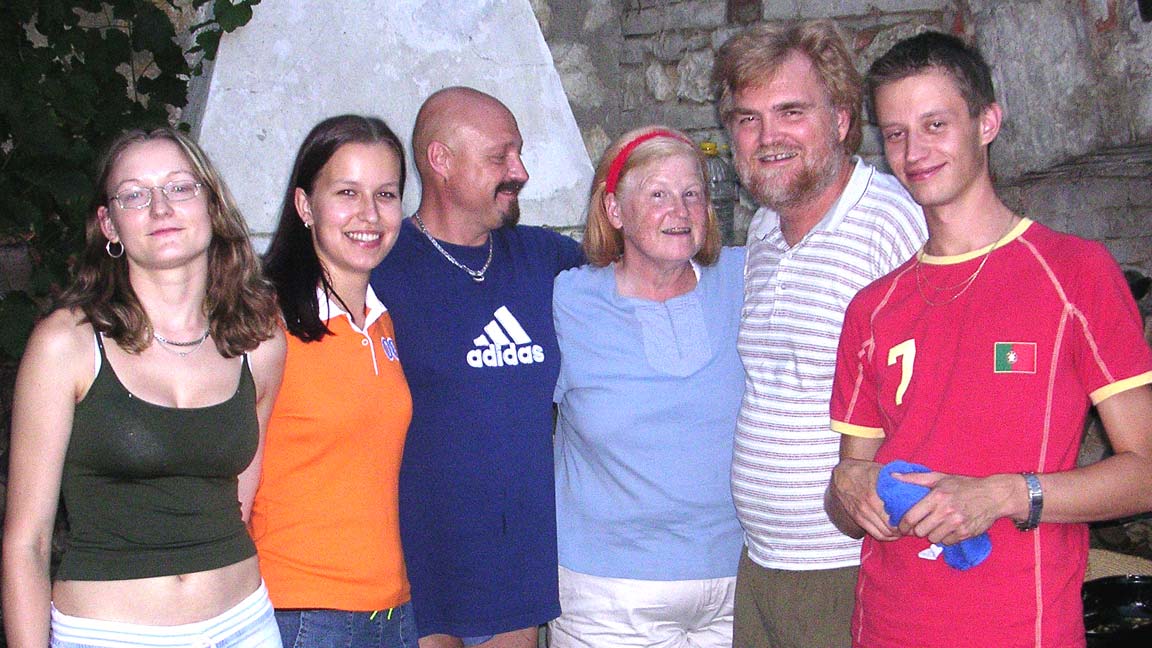
We really did not do much on Wednesday the 18th. We have been trying to figure out how to get to London and when to go there to catch our flight home. We were hoping to change our Air Canada ticket to leave later in the day or leave from Frankfurt. We drove to Brno and finally got a telephone number for them and called. Darned, if they couldn't find our reservations. After we faxed them the tickets the next day, we discovered that we had been reading the return date in error all along. It was not the 4th but rather the 9th of September that our return ticket was scheduled for. We also found out the cost of taking the train to London and it was more than most airline tickets. The bus was not too bad at $75 each. We checked out some other airlines, but all were higher than the budget airlines.
We also had time to stop at two wineries. The wine is sour tasting here and I do not mean bad tasting by that remark. The wines are not sweet and tend to make your mouth pucker a bit. We got a bottle of red, Zweigeltrebe, at the Tanzberg Winery in Bovory. We got a bottle of red at the Turold Winery in Mikolov. After soup and a sandwich for dinner, we called my friends, Bjorn and Heike, in Germany. We wanted to see if they were up for a visit. After that I watched another movie. We had brought several DVD's with and I watched three of them during our three nights in Mikulov.
Fountain Model

We explored the castle ground in Mikulov on Thursday the 19th. Betty got some pottery. We checked out two other budget airlines the Heike told me about, German Wings and a Berlin carrier. Looks like it will be easy to get a cheap flight from Cologne to London. It was late in the afternoon before we drove to several other small towns near Mikulov. We saw another castle with a fantastic wine tasting cellar in Valtice. Like too many other cellars, they expect the tourist to pay to taste. And we would have, if we had come earlier in the day. The cellar was huge and one could try more than 50 wines. We just did not have the time. The cost was the highest that we had seen, but hey it would be worth $10 each to try so many wines at one time. Or would it? Even with taking tiny sips one would quickly loose his sense of taste, or you would be spitting out an awful lot of wine. I know that is necessary for the professional wine taster, but it almost seems like a sin to me. I only wish that we had discovered the place the day we came, because it seems like a good place to spend an afternoon. From here we drove to three other villages looking for and finding ancient ruins, castles and wine tasting. We found all this and more as we enjoyed some beautiful scenery and several lakes. There seems to be a good number of small lakes in this part of Europe. We stopped for cheese and bread to have with one of the bottles of wine we have bought and enjoyed them when we got back to our room in the late afternoon. After the wine we sat out on the patio of our pension enjoying the atmosphere. The hotel owner gave us a couple of slices of some special stuffed pork that he had just barbecued. We tried to watch The Limey, but the last four chapters were damaged. Betty will have to get a copy when we get back to the states.
The weather turned cold Friday. It had been hot in the 90's everyday in Mikulov. Now it hardly got above 70 and it seemed to get colder yet on Saturday and Sunday. It didn't matter, since Friday was a travel day. We slowly but surely made our way across the southern edge of the Czech Republic. We stopped for two hours in Znojmo and for a while in Jindřřův Hradec. Then we made our way to Tábor.
We spent all of Saturday in Tábor. We started by meeting a nice couple from NYC, Eva and Joe. The newly-weds are visiting her parents. We saw the mid-evil tunnels that honeycomb the old city. We spent quite a bit of time in the Hussite museum; Tabor was a center for the Hussites from the founding of the religion. We also walked around the city enjoying all the old buildings. We stopped along the way to have blueberry dumplings; yum, yum! Betty got the recipe, maybe we can make them when we are back in the states. After a trip to the internet shop to book tickets from Germany to London, we went out for a very light supper.
View in Znojmo  |
View in Tábor 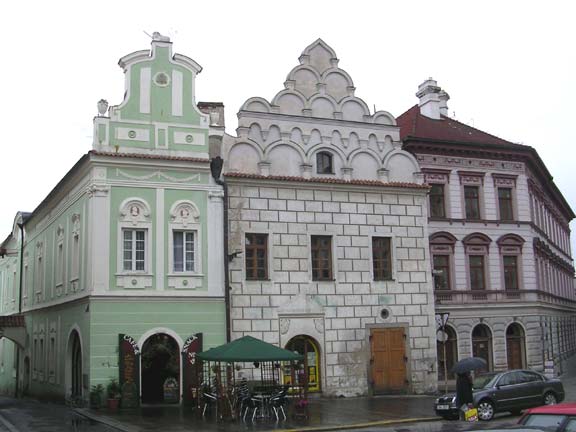 |
August 17, 2004
Bratislava, a Beautiful Pleasant Old City
Press HERE to see a slideshow from Bratislava.
The Church of the Poor Clares
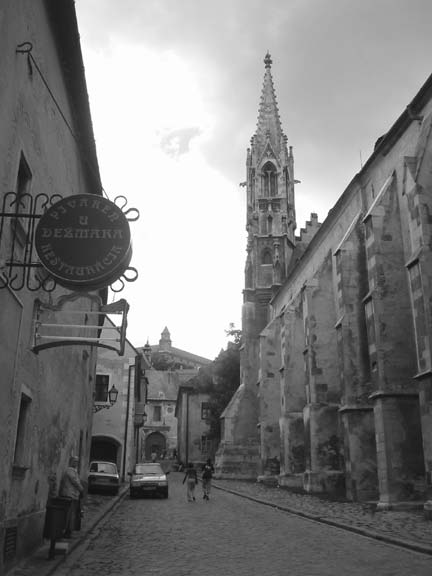
We came to Bratislava on Friday afternoon. We quickly found the tourist information office in the center of the town. We got our first glimpse of the beautiful center of Bratislava. We took their recommendation of Hotel Nivy, about a five minute drive from the center. Although a modern building the hotel has very nice rooms, the cost is $43 per night without breakfast. We usually like to have the breakfast at the hotel, and we did have breakfast here Saturday morning, but the cost-value ration was really bad. Anyway after checking in and taking a brief break, we headed into the center to walk around a bit and get dinner. On our walk we got a sense to the real charm of this place. Unlike the other European capitals, there was easy going and not so frenetic. We stopped to get a USA Today. There we found a lovely restaurant buried in the back of a 250-year old building with a pretty little open courtyard garden. The food was excellent and not very expensive. As we walked back toward the car, we noted the thousands of people in the old center, who were enjoying food and drink - but mostly drink. We stopped to check our email and post a journal entry. They we continued move toward the car, passing by wonderful old buildings and through a lovely park. The night lighting shone on the city, adding an outstanding glow to the life of the city.
The Old Town Hall 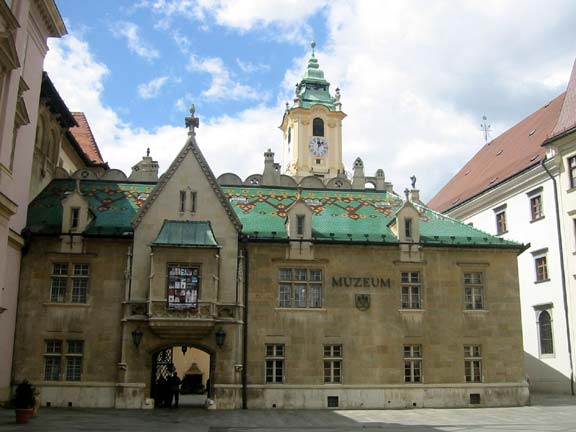 |
The Opera House 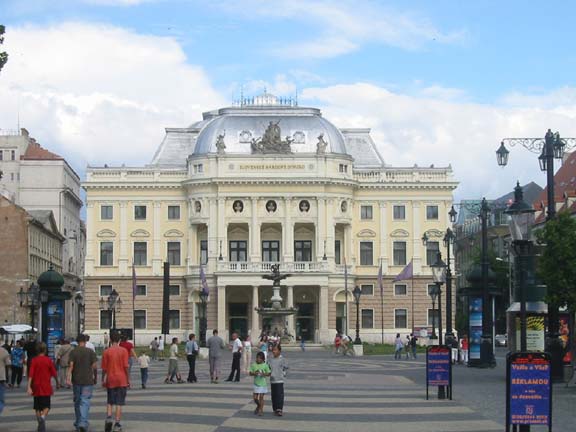 |
Saturday was cool and cloudy all day long. We started with a search for English novels. Betty had to get some books to read. She just is not having a good time unless there is a book in her hand. Unlike my Rio mp3, her Lycos player broke down just a few weeks after arriving in Europe. So I have listened to a number of books while Betty has been reading them.
After getting three books, we took a slow and easy walk around the city. We visited museums, churches, and old and narrow winding cobblestoned streets. We ended at the park in front of the opera house, where we watched a chess game on a giant chess board with 25-foot sides. Finally we returned to the hotel and rested for an hour or so before going out to a Woody Allen movie, Anything Else. The movie was OK and I enjoyed it. We finished up the day in the city center with a good tasting dinner.
The Bratislava Fortress
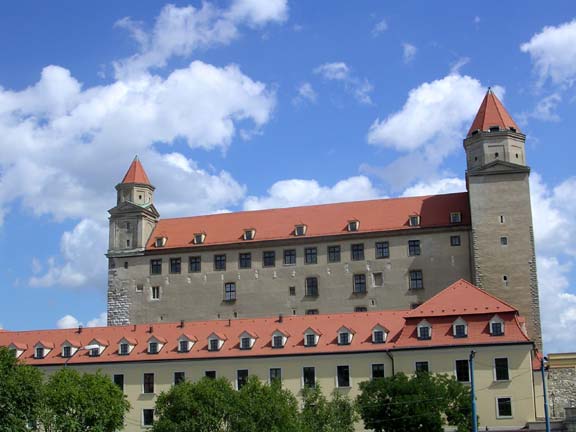
We din not have much planned for Sunday. We visited a couple of castles, we sort of. The first one was an old ruins about 8 miles form the town center in Devon. It was a beautiful location were the Morava River flows into the Danube. The original fortification was built on a rock about 80 meters over the surrounding land. It was quite a sight. Then we visit the massive castle in the center of Bratislava. It looks great but it was built about 1900, so it is not old and has no real historical significance. There was a great view of Bratislava, especially the old town. You can really see how small the city is from this vantage point. We stopped for lunch and beers in the old town. We enjoyed the sun and pleasant atmosphere. Then we went to watch the Olympics.
Castle Ruins at Devon
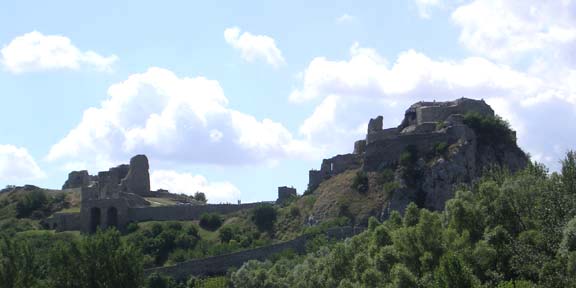
The Spitting Fountain in Trenčín
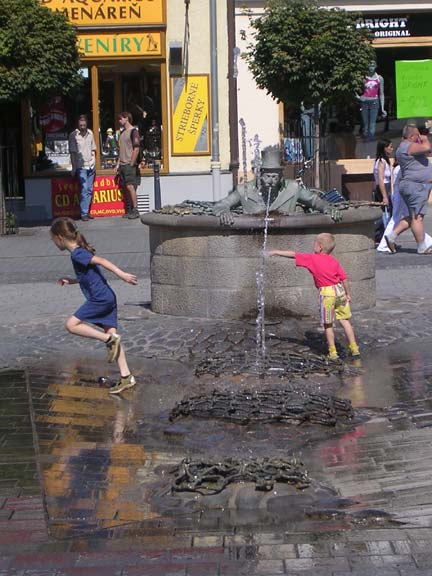
We left Bratislava on Monday. We drove north along the Slovakian wine trail. The only trouble is that they really have no idea what an open cellar is. There are a good number on outlets at the winery or in store in a town, but we only found open cellar. The wine was good, but they had one of those excellent pinot noirs with the heavy plum or cherry taste. It was expensive as wine goes for Eastern Europe at $12, but I had to have it. We also stopped to look at a few old chalets and castles. We stopped at a beautiful small town called Trenčín for the evening. The largest castle in Slovakia is here. It is an old town with wonderful old buildings and many pedestrian only streets. The warm and comfortable life could be seen on the streets and in the faces of its citizens. Betty wanted to stay another day - just because we needed to slow down. I suggested that we do that in the Czech Republic where accommodations are substantially cheaper.
Tuesday morning we spent some time walking around the city and enjoying the views. About noon we headed toward the Czech Republic. We entered and tried to find some more castles, but had trouble running them down. To worsen matters, a bee stung me on my right wrist. It was on fire for an hour. We stopped at a restaurant to get some ice for the bee sting and some coffee and soup. The nice waitress gave me a slice of onion to put on the sting after the ice melted. It seemed to work. Soon we were cruising toward southern Moravia. We found some beautiful old towns there and stopped for the night in Mikulov. We will spend a couple of nights here, more on that latter.
The Trenčín Castle by Night
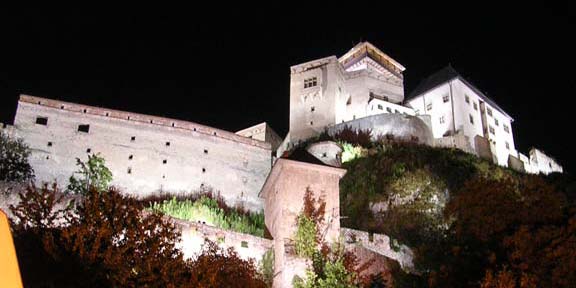
August 13, 2004
Around the Neusiedler See
We came to Illmitz, Austria, on Sunday afternoon. Illmitz is about 45 miles southeast of Vienna. The information office was closed, but they had a listing of private rooms posted on their doors. We wrote a half a dozen down and started driving around the town. It seems that every block had four or five homes announcing rooms to let. We stopped at one that ended up being full and I asked the cost. She said 20 Euros and thought, "This is great!" The next one that we stopped at was only available one night and I saw a sign that said the cost was 18 Euros. I checked out another next door that would be free for several days. She said the cost was 21 Euros. We went off to enjoy a fundraising party for the local church. There was good food and wine available. We enjoyed the live umpapa music, carried on a conversation with a couple from Dortmund, and had a good time. When we returned to our rooms, the owner's son was there. He spoke excellent English. As we talked something was said that surprised me. I stopped everything - back things up and got clear. It seems that all rates for a room are quoted on a per person basis. We were shocked, after all this was not a hotel - yet the cost was $50 a night. To say that I was bummed would be an understatement.
Press HERE to see a slideshow from Eastern Austria.
The Center of Illmitz
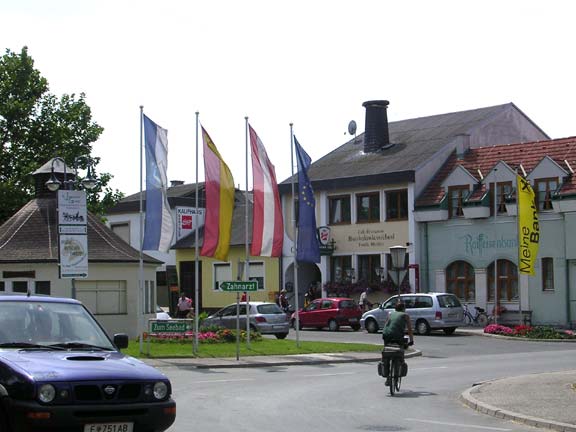
Illmitz is a small, but very busy, village of 2,600 people. There is no library; there is no newspaper. The town and the area seem rich with many vineyards and productive corn fields. All the homes are new, being built after the late 1950's. The area was transformed then as vine culture began to play a major role in the economy. The other economic change is the large number of tourists that come in the summer. They come to play in the Neusiedler See, use the excellent bike trails that wind their way around the lake, and drink the excellent local wines. I can testify as to how nice it is and how friendly the people are. Prior to the sixties, this was a fairly poor area. Immigrants left in droves, mostly for Saint Paul, with little or nothing in hand. The town where the Hensler's came from is not north of Vienna, as I originally thought. It is another small village on the north side of the Neusiedler See - not 30 miles from here. So the families of Michael Seiler and Theresa Hensler traveled more than 4,700 miles from the same place in Austria so their children could meet and marry in Saint Paul. Illmitz was part of Hungary until 1922. Despite the German speaking population, many of the names recorded in the church records are written in Hungarian with a decidedly different spelling. And family records are why we came here only to discover the beauty and the charm of this little village.
Father Johann Zakall
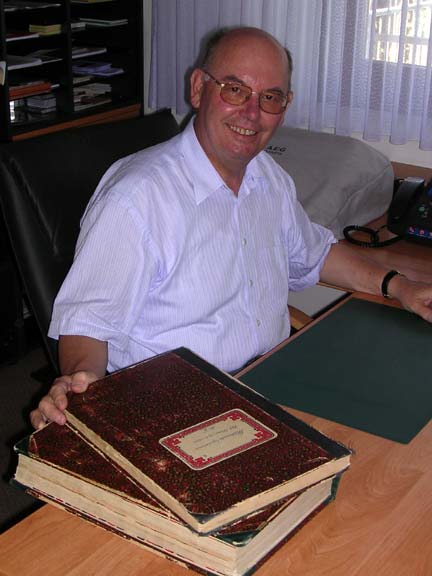
We started Monday looking for a cheaper place to stay. I can say that we had no real luck doing that. So we decided to stay where we were.
We headed for the city hall to check on city records. They only go back to 1895. They referred us to the local priest who had records going back to about 1850. We stopped by the rectory, but he was not at home. We found out that we should check back around 6:30.
We drove to a nearby town to get an internet connection and check for email. Betty bought a jigsaw puzzle that we started working on in the mid afternoon. We dropped by the priest's house later and made an appointment to look at the records the next day.
Tuesday morning we met with the local priest, Johann Zakall. However, he had no record of George Sailer's birth. I say Sailer instead of Seiler, because that is the local spelling of this family name. He told us that Dr. Hans Zelfel, who is the archivist for the bishopric in Eisenstadt, would have older records for Illmitz. He also asserted, as did the people at the city hall, that some records may be kept in Hungary. The only problem is finding where it is kept. Wouldn't it be great if the Hungarians conducted a few censuses prior to 1880?
Then we visited the graveyard. Here we schocked to discover that about 1980 the people of Illmitz completely lost contact with their past by destroying the all the grave markers and reusing the land for new graves. No pictures of the markers were taken; no epitaphs transcribed. After this we drove to Wallern, where Anna Keintz was born, to see the priest. Alas, he was on vacation, so we will write him for information. We tried to call the archivist, but he was not in.
With nothing else to do we visited the lake, the Neusiedler See. The lake is no larger than Lake Millelacs but it is longer and narrower. The lake is very shallow, no more than seven feet deep. There is no beach, just grassy park lawns and reeds. Hundreds of people lined the shore and played in the water. Along with a couple of small ferryboats, there were dozens of small sailing boats on the lake. The water clarity was low around the swimming areas. People come to the lake also for some remarkable bird watching with a large variety of European water birds in the area. We returned in the evening and worked some more on our jigsaw puzzle, it was quite difficult.
The Neusiedler See
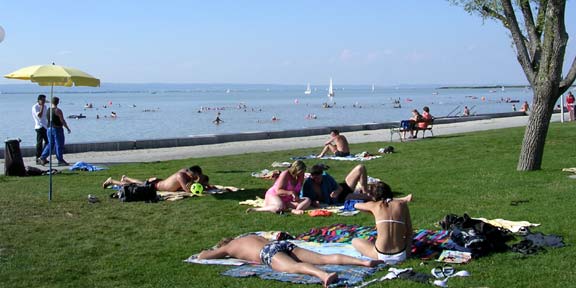
Wilfleinsdorf's Sanctuary
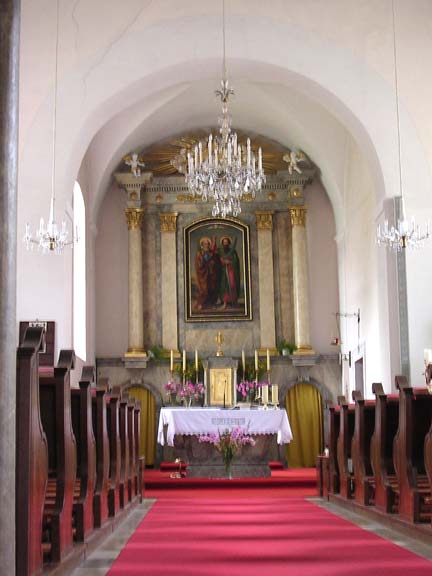
On Wednesday we continued trying to contact archivist in Eisenstadt. By the end of the day we had an appointment early the next morning.
Then with nothing else to do, we decided to knock on a door that had the name Sailer on it. Although we didn't get any information, we had a delightful time. The hospitality of people here is wonderful. We had wine and cookies as we talked and worked out that they did not have info going back further than 1865. Then we wrote up a flyer to post at the church and in a couple of other buildings. After getting it posted we stopped at the house next to the property where George Seiler lived in 1880. The family we visited was Haider, the name of George Seiler's mother. Again the people were wonderfully hospitable. The talk went on for more than an hour and the wine flowed to our glasses. They told us about some local sites worth seeing and about mid afternoon we went site seeing at the Basilica in Frauenkirchen, a 19th century castle in Halbturn, and an ethnological museum that is a town from 100 years ago in Münchhof. Here we met an old lady who had cousins living in Saint Paul. We finished the puzzle and gave it to our hosts. After a pizza we called it a day.
The Church in Rohrau
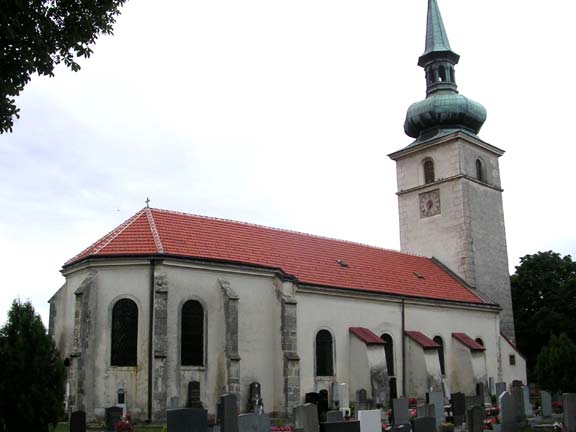
Thursday was definitely the most productive on the ancestor quest. We were in Eisenstadt by 9:30 and digging into records from 1700 to 1850. We did our best given our lack of the German language. We were able to confirm much of what we already new, add some new dates, go back an additional generation, and capture the names of the brothers and sisters of the first great-great-grandfather Seiler to come to the Saint Paul. Betty seemed to really get into the research. It would be nice to go back again, but we would not be able to get space until next week. So what we got will have to do for now. Perhaps we will return one day.
At 4:30 we headed toward Wilfleinsdorf, the tiny village where Martin Hensler was born. It is about 15 miles southeast of Vienna. It is so small that there is not a functioning pension, so after driving around a bit - we drove to Bruck, a few miles to the east. Here we found a guest house that was high but not too bad for Austria at 56 euros or about $67 for the night.
Today we decided to stop at several cemeteries where Hensler ancestors might be buried. Like the other cemeteries that we have visited the old gravestones seem to be gone. To be sure they were a bit older than in Illmitz and Wallern. Still there were not grave markers of people buried in the 1800's, let alone the 1700's. In Rohrau where Gregor Hensler (died in 1765) could be buried, the church was founded before then, but the bulk of the structure was completed in 1776. Here we found markers, attached to the church, that were as early as the 1700's. Rohrau is only 30 kilometers east of Wilfleinsdorf , and another 30 kilometers to the east is Bratislava. And that is where we drove. The people on this side of Slovakia seem to be as friendly as the Austrians. Will let you know if this is true on the next posting.
Wine and Wind Culture in Burgenland
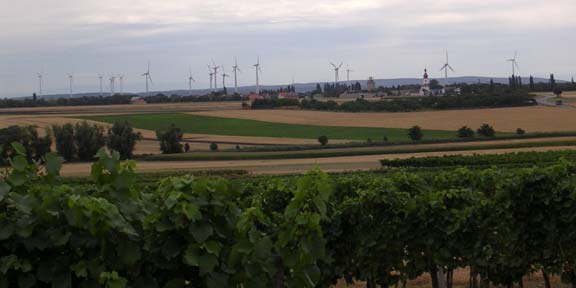
August 08, 2004
Again in Wonderful Hungary
On Wednesday we came back to Hungry.
We had heard that due to lots of August vacationers there were long delays at the border crossing east of Arad. We decide to drive about 25 miles north of Arad and turn east to cross into Gyula, Hungary. The crossing was fast and uneventful - as all crossings should be.
There is an immediate change that is noticable when entering Hungary: clean and good roads, dust-free air, lush fields, and an easy atmosphere. We both think that is the nicest county that we have visited.
We drove as far as Szeged and were delight at this city. It seemed to have a good number of tourists but it was not overwhelming. We found a pension after a trip to the Hungarian Tourist Information Office. They are at least as good as the Czech tourist offices and maybe better. We checked in and then headed to the center for a walk around the town. We had already seen the magnificent central plaza and parks when we arrived and now we were looking at the old churches and institutions. A beautiful river flows through the town. After a couple of hours we were tired and hungry enough to look for a restaurant. We tried a Tex-Mex place. The Mexican food was just awful, but very reasonability priced. Still, I long for some good enchiladas. With dinner over we retired for the evening.
Press HERE to see a slideshow from Western Hungary.
The Public Art of Szeged 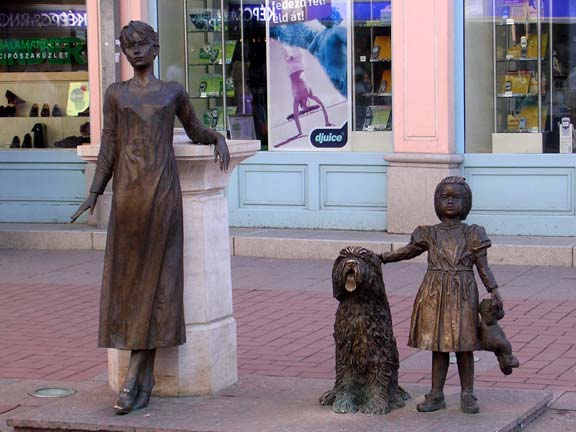 |
Lace Maker in Kiskunhalas 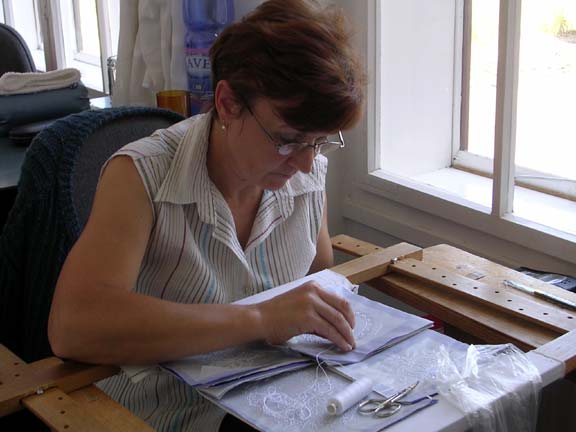 |
Before we left town on Thursday, we stopped to by a USA Today. It has been easier to get this paper in Hungary than any other country. To be honest, I only want the cross word puzzle, but Betty seems to like reading all the news - even if it comes a day late. We slowly made our way toward Pecs. We stopped the small town of Kiskunhalas. It is famous for its lace. The museum only cost a couple of dollars to visit. The workmanship displayed was extraordinary. At the end we inquired as to what was for sale. The cost for us seemed astronomical. For example, a piece that was about twelve inches in diameter cost more than $1000 and piece the size of postage stamp cost $45. So, we bought a couple of pictures of the lace on postcards. We really enjoyed our stop here. After Kiskunhalas, we traveled to the very small village of Hajos. Here hundreds of wine cellars line a few roads along the highway. We visited two wineries. For two dollars you can buy a liter of good wine in a plastic bottle. We got three very inexpensive bottles from János Hepp and one of higher quality from Varga Mihály for $10. The daughter of the vintner, Ericka Varga, spoke good English and was very kind to us. We will try to hang on to it until we get home.
From here we drove to Pecs. It immediately felt warm and inviting. We took a room at the Laterum. While not the most inviting place it was cheap. We ate there and found the food overly salty. Our speculation said that soup and sauces came from a can.
János Hepp and Betty 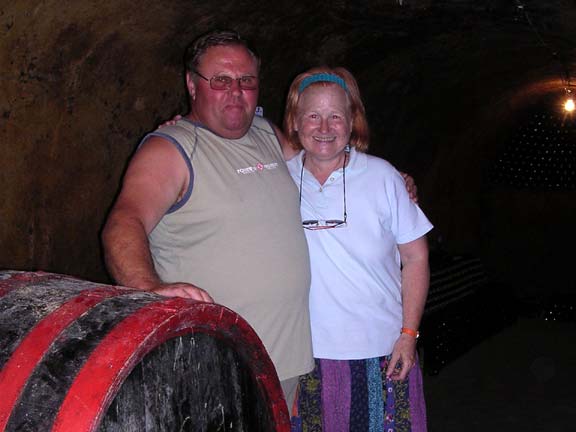 |
Ericka Varga 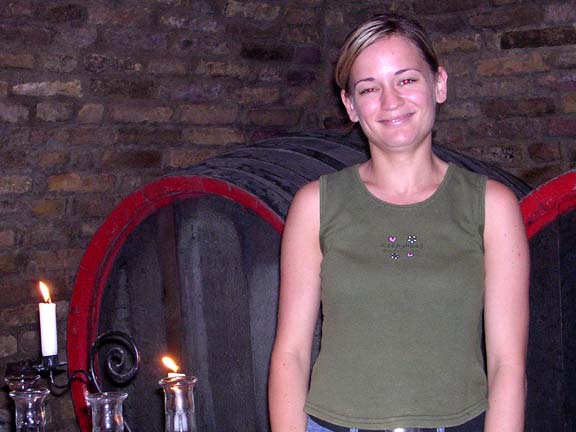 |
Ruins in Pecs
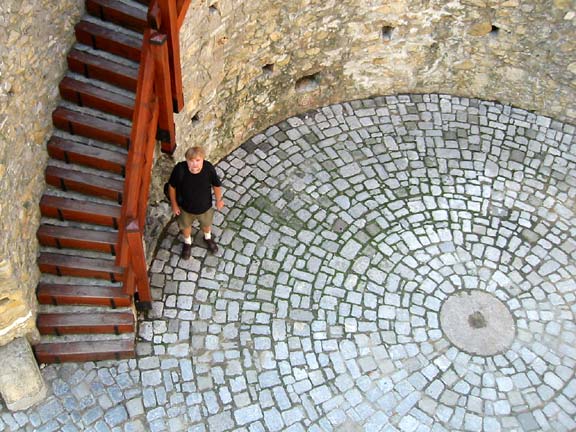
We had planned to stay two nights in Pecs. The next morning we began to explore the city. But we quickly decided that it wasn't as great a place to visit as we first thought. They really overplay the tourist stuff. It is another town that nickels-and-dimes you to death on entrance fees for everything. Most perturbing to us is that many of the churches in Hungary charge a fee to enter and in Pecs the fee was the highest at $3.50 and the church the least. These are active churches and nowhere else have we found such fees. We get the impression that they have never heard the story of the money changers that cast out of the synagogue.
So Friday, about noon, we decided to leave town and head north. We took several small roads through a hill area north of Pecs. Eventually the land flattened out and we were speeding toward Lake Balaton. The lake is about 50 miles long and three miles wide. It is the only grand lake in Hungary, so it is heavily used by families, especially on the southeast side, where there is a shallow sandy bottom that allows wadding several hundred feet from the shore. The crowds disturbed me so we headed to a\the town of Keszthely at the far southwest corner of the lake. We looked for a room, but found nothing in our budget. So we looked for a while on the northwest side of the lake. Finding nothing we headed north and stopped in the town of Sü meg. We found a pension fairly quickly. It was one of those places that was quite unexpected, because there is a marvelous old castle ruins on a high hill that overlooks the town. We walked to a nice restaurant at the foot of the hill and ate Hungarian food, which we both like.
Saturday morning started with one of the best breakfasts that we have had in pensions that we have stayed at. It also started with a heavy rain storm. We decided to skip the climb to the castle and head north. As we drove the skies cleared and the sun began to shine. By the time we got to Györ the weather was warm and sunny - perfect to explore the city. This was another of the really great Hungarian cities that we have seen. We took a few hours to see the major historical buildings, and to visit the town's commercial center. I should mention that unlike the states, nearly every town and village has marvelous pedestrian areas with out door cafes and public art. It was late afternoon and we had a choice to make: stay or move on to Sopron. We choose the later. We wasted too much time searching a cheap place to stay. When we finally made up our minds where we wanted to stay and returned to them - we found them full. So, we turned to a slightly more expensive pension. Here we found a wonderful hostess that spoke good English and made us feel very welcome. When we told them that we were looking to eat she gave us some wonderful apricot dumplings that she had just made. Then they volunteered to cook a real Hungarian food dinner for us. And it was a marvelous goulash plate with homemade noodles. We drank the wine we had bought in Hajos.
Sü meg Ruins 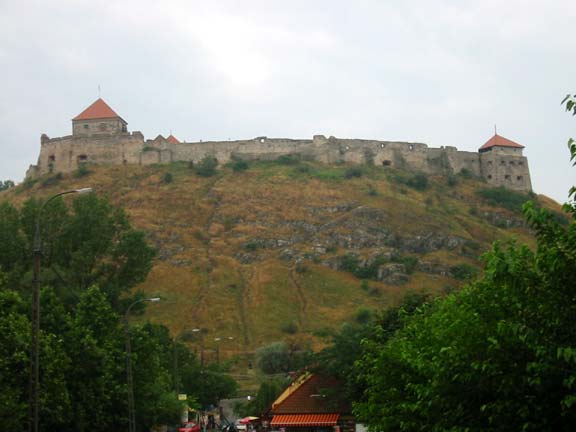 |
Györ Street 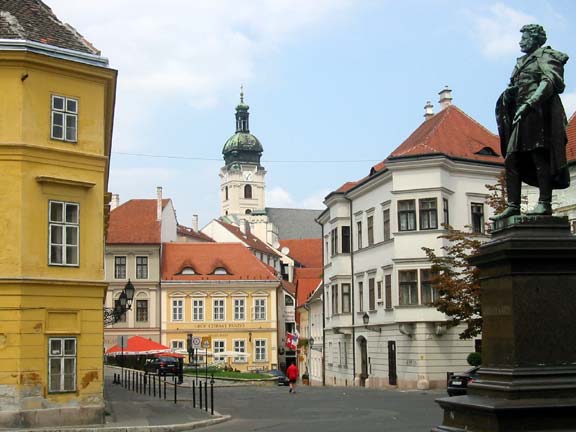 |
Today we began with an early, good breakfast. Then we explored the town. It is replete with Roman ruins and a marvelous old city center. Here a flee market was in progress, where one could find the typical junk and some great old antiques. I climbed the clock tower. We visited only one museum, a bakery museum. It was interesting in two ways: one - it had a lot of ancient bakery gear; two - it spelled out two hundred years of the family of a baker. I wish that we could have spoken in Hungarian to the people running the museum, as they were the grandchildren of the last baker. The bakery had been there for more than two hundred years before it closed in 1974.
From here we drove a few miles back to Fertöd to visit the Esterházy castle. It is billed as the Potsdam of Hungary. It is a lovely old Versailles-type castle. What I liked best is that it is still not totally restored. It is like looking at antique furniture in that it is more interesting when the finish is not messed with.
From here we passed into Austria to the village where Betty's great-grandfather Seiler came from. We will probably stay in Illmitz most of the week: looking in graveyards and looking for church and public records about here ancestors. We will likely do the same next week when we look for the ancestors of great-grandfather Hensler north of Vienna.
sopronFleeMarket.jpg 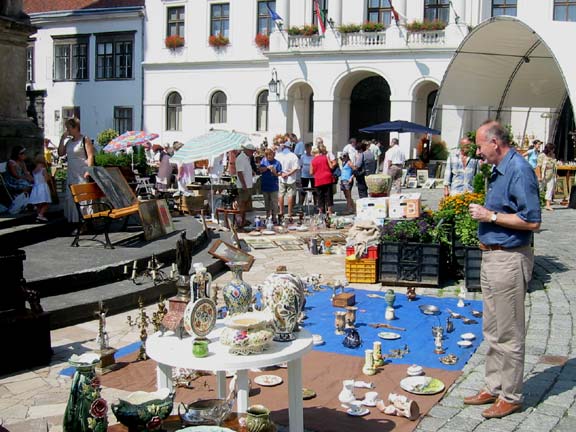 |
Esterházy Castle 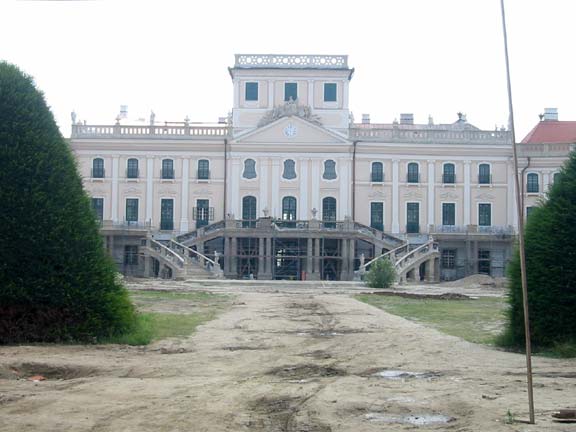 |
August 03, 2004
Timişoara and Western Romania
Sunday we took a leisurely drive from Craiova to Timişoara. The driving was slow due to lot of road construction on E70. There is nothing to say about the first hundred kilometers. Once we reached Drobeta-Turnu Severin it all changed. First there was about 20 kilometers of the most beautiful river imaginable, the blue Danube. It is a spectacular river with wonderful views along the road. We stopped to view a working monastery. At Orşova we turned north into a fantastic Timiş River valley. The valley , was lovely, often with steep or rocky slopes. Along the way we saw farmer selling foods: tomatoes, melons of all types, blackberries and potatoes. Still other sold honey or homemade wine or schnapps. We continued to see the ubiquitous Romanian horse and wagon. The only thing that I could say that was irritating about the drive was how dangerous the roads and the drivers are here. They seem to live with a death wish when they drive, and I guess many of them are granted their wish as their rate for highway fatalities is six times the rest of Europe. The 200 kilometer trip seemed to take forever, but we eventually arrived in Timişoara. We stopped at a couple of hotels. Their rates have doubled or tripled in the past two years, so we decided to check out a pension or two. Luckily we had acquired a telephone like directory early in the trip in Romania. It has maps of many of its larger towns, and directory listings of hotels and restaurants. We made good use of it here. The first pension, the Pensiunea Casa Leone, was just great and the price was good at $36 per night including breakfast. We ate some excellent Italian food at Da Toni just a few blocks away.
The Blue Danube
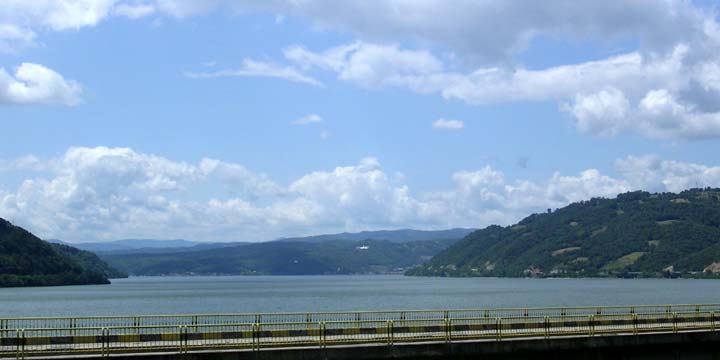
When we arose, Betty was not feeling all the great. I left her sleeping until our breakfast was ready. After breakfast she laid down and I did some writing. But about eleven, I was done and so I called Mihael. We had met her and her husband Octavian when we were on the Romanian Black Sea coast. We stayed in touch by email so it was easy to call. They came by about a half-an-hour later. They both are journalists and so our tour began at their newspaper, the Renasterea. The conversations throughout all this were wonderful and wide ranging. They got even more interesting when we met the editor-in-chief Adrian Pop. He is one of those cynical old news hounds of the yesteryears, extremely skilled at putting out a newspaper even with some pretty fierce competition from some Austrian carpetbaggers. I found him delightful and exasperating at times. No doubt the hard edge and sharp humor is meant to test the intellectually weak. With our having been out the proverbial intellectual loop since we left home, I really enjoyed our conversations with him. Of course, his big question was "Is Bush going to win in the fall?" Up until a few months ago, I would have easily said, "Yes." But as it stands now, I am thinking that Kerry actually has a chance. Bush has so botched the Iraq war and the War on Terrorism that I wonder if the American people will let him continue to make such a mess of it. Kerry would certainly win, if Americans were able to understand the mess he has created - but, alas, my countrymen have never proven to be all the bright - at least in the short run.
After the conversation, we explored a bit of the city together, seeing the bastion built by the Turks, the old town square and many of Timişoara's old and important buildings. The German influence on the architecture here is very pronounced. Then we walked to the new city center with the opera house at one end and the Orthodox Cathedral at the other end. This cathedral was the second most beautiful orthodox cathedral that we have seen. It was on the steps of the cathedral where children were murdered, and more than 200 people in the fronting square were killed as the 1989 revolution began here in Timişoara. Bullet holes were still visible on an apartment building beside the square. From here we slipped over to a lovely park to rest before returning to the car and our hotel.
Press HERE to see a slideshow from Timişoara.
Betty with Octavian and Mihael Roşa 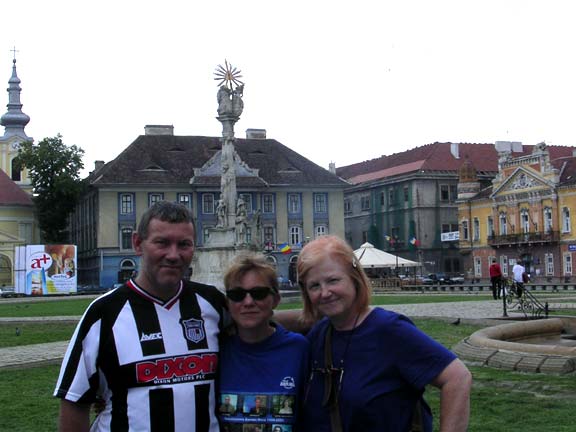 |
In the Old Town Square 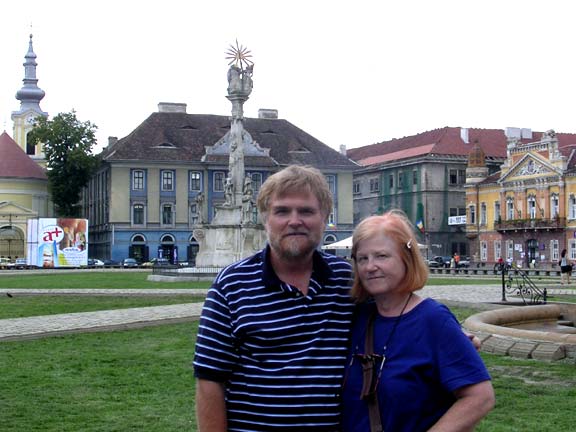 |
Timişoara's Orthodox Cathedral 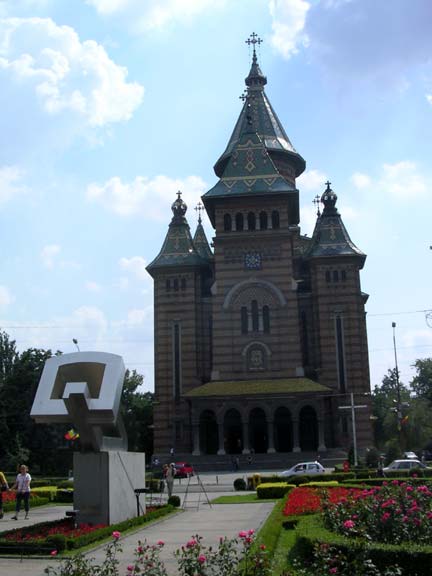 |
In the Cathedral 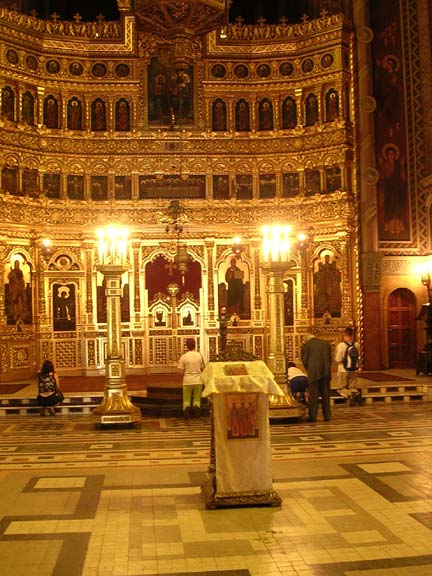 |
Two hours later Octavian and Mihael returned to pick us up. We went to see there apartment. It was the typical socialist era flat. I thought the building to be 40 or 50 years old, but was surprised to hear that it had been built only 25 years ago. The fourth-floor apartment had about 600 square feet with one bedroom and a living room and a lovely balcony. With no lift the climb was an exercise. We drank wine and continued to talk. The entire day the major conversation revolved around their immigration to Canada. It seems that Mihael's uncle has lived in Toronto for many years. He visited the family just last week, and put the immigration notion into their minds. They are very seriously considering a move to Quebec. So, they had lots of questions about life in Canada and the USA.
On the next leg of the evening, there came a real treat. We visited Mihael's parents, Florian and Elena, who are lovely people. He worked as an iron hanger all his life, but he was lucky enough to work in Germany in the mid-70's where he earned enough to build his beautiful little townhouse. We ate a traditional Romanian meal of cabbage rolls - filled with rice and pork - covered with sour cream and thin tomato sauce on the side, and great dollop of polenta or as it is sometimes called in the states - corn meal mush. After dinner we continued drinking the Tokay wine that we had brought and talking late into the evening. Finally about one in the morning we headed back to our hotel.
Florian and Elena 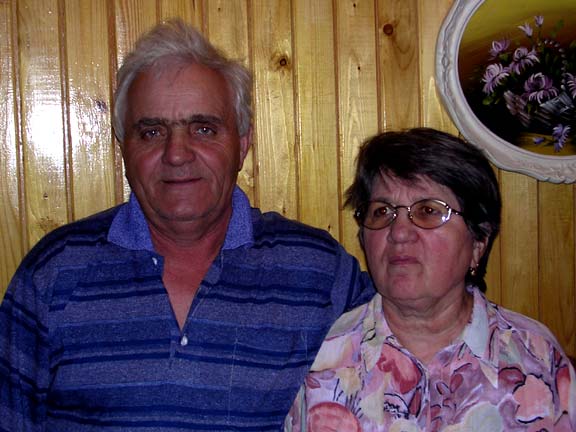 |
Cabbage Rolls and Polenta 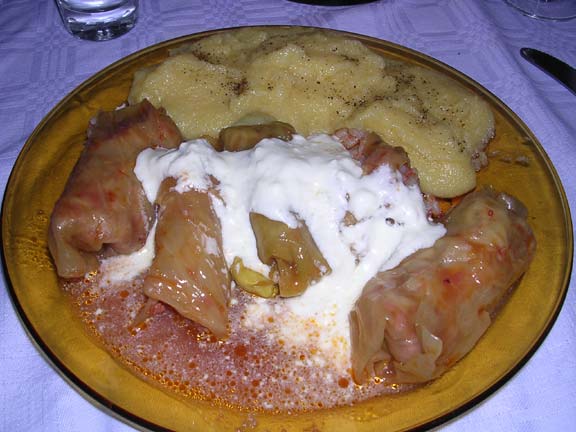 |
Today we are taking it easy. Betty still is under the weather, and hence an extra day in Timişoara. We have had to wash our clothes out in our room at night for the past three weeks. I was pleased to find a laundry here, so we will finally have all clean clothes again.
Also today is Timişoara Day in the city. Maybe we can catch some of the festivities in the old town square. We also might try a movie. If Octavian and Mihael do not have to work super late, they will drop by at the end of their workday around 9:30 in the evening. If anything interest occurs we will let you know. We will be headed back to Hungary tomorrow.